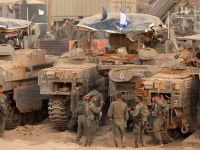US Defense Secretary Donald Rumsfeld is set to unveil sweeping changes in US military strategy, including the formal abandonment of the "two major wars" yardstick that for a decade has been used to determine the size of the military, the Washington Post reported Monday.
Rumsfeld is scheduled to meet with President George W. Bush this week, probably Wednesday, to seek final approval for the new strategy, which appears to involve some of the biggest changes in the U.S. military in a decade, the Post quoted Pentagon officials as saying.
Rumsfeld would publicize the strategy next week, perhaps with a White House announcement followed by congressional testimony, the Post quote the officials as saying.
Bush was due to make a speech at the Naval Academy on May 25, outlining the "vision of where we need to go as we move into the 21st century," a Pentagon official told the Post.
For about a decade, the U.S. military has used the possibility of having to fight wars in two places -- Korea and Iraq are the two examples frequently used -- to figure out the minimum number of troops, airplanes, ships and gear needed.
Abandoning that approach will remove a floor that for years has kept the active-duty military at about 1.4 million people, according to the Post.
LESS EMPHASIS ON CONVENTIONAL WAR PREPARATIONS
Rumsfeld has been conducting a top-to-bottom review of strategy and arms. The administration wants to move the cumbersome Cold War U.S. military away from a decades-long thrust toward all-out war with the former Soviet Union toward threats posed by high-tech arms proliferation today.
The Post said defense officials were guarded about describing what will replace the two-war yardstick, but one of those involved in the strategy discussion put less emphasis on preparing for conventional warfare, and more on handling murkier situations such as defending Taiwan from a Chinese blockade or keeping open the Strait of Hormuz.
Cutting personnel also would free up money for the new weapons Rumsfeld wants to buy, the Post said.
It said the change in approach would probably affect all the services but appeared likely to have the greatest impact on the Army, the most manpower-intensive service in wartime.
The strategy also calls for the US military to focus less on Europe, traditionally the Army's bailiwick, and more on East Asia, which because of its long distances and island nations, has been seen as more of a theater for the Navy and Air Force.
The revised strategy also calls for the military to do a better job of assimilating new information-age technologies and countering the proliferation of missiles in the Third World, according to the Post report -- WASHINGTON (Reuters)
© 2001 Al Bawaba (www.albawaba.com)







